Deciding to go on this trip was a no-brainer. Our 2 ½ month old daughter needed to be introduced to her grandparents (who live in St. Pete) and her great grandmother (who lives in Orlando). Combine that with a Trans Am street race that we could get into with our SCCA scrutineering credentials, and the choice was obvious, so we headed south to warmth, family, and racing.
Registration was a bit confusing; Bob (our Central Florida Region contact) told me that it would be moving around, so when my dad and I got there, we should just ask around. When we got to the race on Friday morning, we were told that registration was about 10 blocks away at the Bayfront Center in downtown St. Pete; we got there and back with only modest delays due to traffic, and checked in at the SCCA Pro Racing trailer. Since the World Challenge staff was at the time limited to Mitch Wright and David Kettler from Pro Racing, we were assigned to help them for the rest of the weekend. For those unfamiliar with the series, World Challenge consists of two "Touring" classes of tub based sedans and coupes which are allowed limited modifications from their stock form, and two "Sport" classes with somewhat different rules that don't appear at as many races. T1 contains cars such as the Acura NSX, Ford Mustang, and Chevy Camaro, while T2 includes the Honda Prelude Si, Acura Integra R, and Saturn coupe.

We pitched in, helping with check in and initial weighing of the World Challenge cars and some limited safety inspections, and then went roving through the World Challenge paddock, double checking on harness age and condition, fire bottles, and seat back supports. Now I had known that there might be some drivers & teams that Allison and I knew in the paddock this weekend, so it wasn't entirely a surprise when Dad and I ran into Alain Chebeir [pictured on right], whom Allison and I have known for years and who is currently driving a BMW 325i in the World Challenge T2 category. Alain is very fast, and was looking to have a good weekend.

The safety check was interrupted by practice, so we took a little time to visit other portions of the paddock. One friend that I knew would be there was FF2000 driver Andy Lally [pictured on right], who won the overall NESCCA championship last year and placed extremely well SCCA Valvoline Runoffs®. Andy's race at Walt Disney World in January had been a bit disappointing. He started third, but his front wing was damaged early in the race and had to pit, putting him a couple of laps down, and out of the points. Andy was looking for a better finish this race, and stood a fair chance, as generally he has a cool head and doesn't get into trouble when he can avoid it.
We also checked out the Spec Racer Ford paddock, and encountered another well known Northeast Division driver, Mike Buck. Mike has actually written up his experiences from the 1996 race at St. Pete, and they appear in the next article in this issue of the Journal.
After lunch, Mitch decided that he wanted to get some trap times. There was a minor complication because there was no battery pack for the radar gun, only a cigarette lighter plug. We pondered the situation, and realized that worker parking was inside of turn 8, not too far away from the track. Mitch decided that speeds exiting the corner would be interesting to get, so we pulled dad's Alfa Milano to a point about 30 feet away from the track, and used the extremely long cigarette lighter extension cord to get the gun into place. Afterwards, Mitch concluded that these speeds weren't as useful as he'd hoped, and then decided that he really wanted speeds from as close to the end of the front straight as possible. We scouted for a suitable location, and found a flagging station just past the pedestrian bridge that offered as good a spot as we were going to find. The next morning, Dad and I went through the paddock marking the tires (World Challenge cars must start the race on the same tires they use in qualifying), and Mitch came up with a car battery that could supply power for the radar gun. Rob Elson, who was handling Trans Am tech, decided he wanted some trap times as well, so we ended up with a lot to do. The good news was that we got the key to one of the golf carts so we only had to carry the battery over the pedestrian bridge to the other side of the track -- we could use the golf cart to get the battery from the Pro Racing trailer to the foot of the bridge.
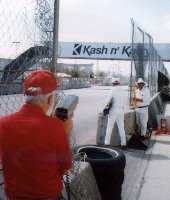
The World Challenge cars came out for qualifying; Mitch had suspected that we wouldn't see that much of them, as they might decide to only take 3 or so hot laps to avoid abusing the tires they'd start the race on. We were therefore quite surprised when most of them stayed out for quite a few laps. The pace was set in T1 by Peter Cunningham's Acura NSX; he managed to hit 140mph on our gun at one point. T2 was a bit slower, but our friend Alain managed to set fastest lap in qualifying (just barely.) SCCA Pro kind of scrambles the top 5 in all their events to make things more interesting, so the fastest driver & car rarely end up starting in the pole position.
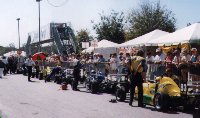
Then the Trans Am cars came out for qualifying. They weren't as fast as we expected relative to the T1 cars; the quickest cars were in the 154 and 155 mph territory. However, it did occur to Dad and I that we were calmly setting up the radar gun and measuring the speeds of race cars traveling 155 mph 10 to 15 feet away. After we finished up with some speed measurement, we headed back to the Pro Racing trailer, and we ended up getting to head over to the grid area as the FF2000s were lining up for their qualifying session the first thing after lunch. It was pretty amusing, as the crowd lines up right next to the false grid, and there's a row of food stands behind them, so the spectators are lined up looking at the cars and eating lunch.
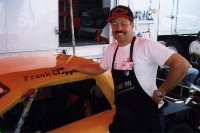
During the lunch break, I decided to check out one team in the Trans Am Paddock. For the past
couple of years, Frank Cioppettini has run a white GT-1 Camaro in the Northeast with Clover
Enterprises sponsorship; when I saw a yellow Clover Enterprises car I became more than a little
curious.
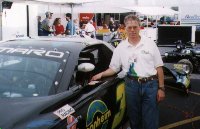 I wandered over to check, and sure enough, it was Frank; he'd sold his white car and
bought a more modern one, a 1994 Riley & Scott chassis, and was looking at moving up a rung.
We chatted briefly, and I got Frank to introduce me to Don Meluzio, who I'd seen running in the
Northeast for a couple of years, but never actually met. I passed on the information to Don that
his trap speeds on the front straight were quite comparable to the front runners, news which he
was very pleased to hear.
I wandered over to check, and sure enough, it was Frank; he'd sold his white car and
bought a more modern one, a 1994 Riley & Scott chassis, and was looking at moving up a rung.
We chatted briefly, and I got Frank to introduce me to Don Meluzio, who I'd seen running in the
Northeast for a couple of years, but never actually met. I passed on the information to Don that
his trap speeds on the front straight were quite comparable to the front runners, news which he
was very pleased to hear.
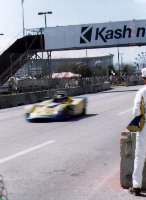
After lunch, we went back for more speed measurement; the plan was to time the Trans Am
practice, and ½ of the World Challenge race, and then head back to help with World Challenge
impound. We got over there a little early so we could watch the first Spec Racer Ford Pro race of
the weekend (another was scheduled for Sunday.) We got some speeds; the front running SRFs
were running about 105 as they passed our station. After we got an idea of how fast they were
going, we sat back to watch the race.
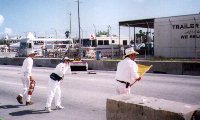 Things got a
little exciting when one of the SRFs tagged the wall opposite us a little before reach our station;
the car careened across track shedding bodywork, then spun back across coming to rest with its
nose against the wall. My father is new to SCCA racing and race workers, and got to see a
display of top notch SCCA corner workers in action.
There was some initial concern as the driver complained about lower back pain, and a
backboard was used in a careful extraction managed by SCCA Emergency Services workers and
the St. Pete Fire Department, but later that day the driver was released from the hospital in good
condition.
Things got a
little exciting when one of the SRFs tagged the wall opposite us a little before reach our station;
the car careened across track shedding bodywork, then spun back across coming to rest with its
nose against the wall. My father is new to SCCA racing and race workers, and got to see a
display of top notch SCCA corner workers in action.
There was some initial concern as the driver complained about lower back pain, and a
backboard was used in a careful extraction managed by SCCA Emergency Services workers and
the St. Pete Fire Department, but later that day the driver was released from the hospital in good
condition.
As we approached the start of the World Challenge race (which was scheduled for Saturday afternoon rather than for Sunday), the sky clouded up. As the pace laps started, the rain started too. The WC cars took about 10 laps with the pace car out front, and after two cars spun under the full course yellow, the Chief Steward decided to bring in the field and let them switch to rain tires. It was clear to Dad and I that we weren't going to get useful speeds in the rain, and we'd left our rain gear back in the car, so we packed up and headed off to the car to get some wet weather clothing, then headed over to help with impound. Thus, we didn't get to see what happened to Alain, but he finished a disappointing 6 laps down.
In impound, Mitch decided he wanted the heads off the top 3 cars in T1 and the top 3 in T2, so he could get bore, stroke, and valve diameter measurements; he also wanted to take the cams from the Acura Integra R that finished 5th overall. I was assigned to watch over the Realtime Racing area, where heads were to be pulled off the Acura, the Prelude Si that came in 4th overall (2nd in T2), and the T1 Acura NSX that finished 1st overall. Dad was assigned to watch over the winning T2 car of Peter Schwartzott that finished 3rd overall.
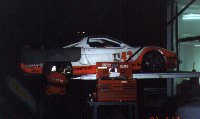
The folks at Realtime were slightly annoyed at the fact that Mitch asked for heads; while it's fairly easy to pull a head in most cars, in the NSX they had to drop the rear subframe out the bottom of the car -- and nobody brings a lift to the track. They ended up putting the NSX on the rear gate of their trailer (one designed to lift a car so they could have two levels of cars in transport inside) with its back end hanging off. So far as we know, all the cars cleared inspection and the provisional results stood; Alain Chebeir packed up pretty quickly so I didn't get a chance to ask him what happened out there.
When we were released from babysitting detail, World Challenge was done for the weekend, and we ended up assigned to help with SRF the next morning. Tired, we headed home to recover.
Allison hadn't come out for the first two days, but decided to come to the race on Sunday. As it
happened, Dave Liddle from SCCA Enterprises had mostly gotten through the rules compliance
work he was interested in on Saturday, so Sunday was a fairly easy day.
here was an incident
early in the FF2000 race on the back straight between a couple of cars from the rear of the pack,
and one other incident I don't know much about, 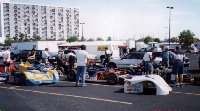 but Andy Lally managed to finish 5th, in the
points and the money, which was a big improvement over his race in Orlando in January, and a
good accomplishment on an unfamiliar and tough street course.
The Spec Racer Ford race
ensued, and it was good one. Mike Buck managed a 5th, his best Pro finish ever.
Our duty as the cars returned to the Paddock was to make sure that the
transponders for Timing and Scoring were retrieved;
we achieved 100% success,
but I had to stop one driver who was in a hurry to get home -- literally
stop,
as he was loaded up and driving his rig out of the area when I spotted him.
In impound,
Dave Liddle pulled out the Ford OBD II diagnosis equipment, but so far as I know, he didn't turn
up anything suspicious in the theoretically identical cars.
but Andy Lally managed to finish 5th, in the
points and the money, which was a big improvement over his race in Orlando in January, and a
good accomplishment on an unfamiliar and tough street course.
The Spec Racer Ford race
ensued, and it was good one. Mike Buck managed a 5th, his best Pro finish ever.
Our duty as the cars returned to the Paddock was to make sure that the
transponders for Timing and Scoring were retrieved;
we achieved 100% success,
but I had to stop one driver who was in a hurry to get home -- literally
stop,
as he was loaded up and driving his rig out of the area when I spotted him.
In impound,
Dave Liddle pulled out the Ford OBD II diagnosis equipment, but so far as I know, he didn't turn
up anything suspicious in the theoretically identical cars.
The Trans Am race was a good one, but has been extensively reported on elsewhere. Frank and Don both finished; Don finished particularly well, in 6th place, a really excellent result. Tired and sore, we considered it a good weekend and headed home.
<& /components/GenericFooter.mhtml &>